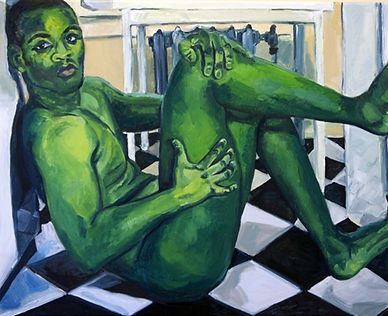Syllabus
Painting II Art 2320 Spring 2021
Prof. Elizabeth Albert
Course meets Tuesdays 12:15-3:05 SJH Rm 404; Fridays 12:15-3:05 via zoom
Office Hours: TF 11:00-12:00; 3:30-4:30; W 9:30-10:30 SJH B3A
email: alberte@stjohns.edu
text: 646-373-1517
course website: https://elizabetalbert.wixsite.com/website
Course Description
This course builds upon the foundation established in “Painting I,” and seeks to expand student awareness of the compositional and material possibilities of the medium of painting with regard to students’ individual expressive purposes. The first half of the course will be dedicated to series of projects based on observation, imagination, and other source material. In the second half of the course students will develop and complete independent sustained projects emphasizing content, context, and process, and enhanced by their research in both historical and contemporary art.
Course Requirements
-
Focused application to projects (both in-class and homework)
-
Active participation in group critiques
-
Successful completion of each phase of all projects by the due date
-
Appropriate presentation of completed work
-
Regular attendance
Grading Policy and Breakdown
Grades reflect concept, planning, technical execution, and effort. Final grades are based on an average of the following: Each project is worth 10% and each homework assignment is worth 5% of the final grade. Grades reflect concept, design, and execution (final result). 20% of the final grade will consider participation during critiques, attendance, punctuality, and observation of due dates. Respectful maintenance of the studio will account for 5% of the final grade.
The grading system is as follows:
A = 4.0 or 100 - 95 Excellent
A- = 3.7 or 94 - 90 Excellent
B+ = 3.5 or 89- 87 Very good
B = 3.0 or 86 -84 Very good
B- = 2.7 or 83 -80 Good
C+ = 2.5 or 79 - 77 Good
C = 2.0 or 76 - 74 Satisfactory
C- = 1.7 or 73 - 70 Satisfactory
D+ = 1.3 or 69 - 67 Adequate
D = 1.0 or 66 - 60 Marginal
F = 0.0 or 59- 0 Failure
Attendance Policy for Studio classes
Attendance to all classes is required. The Department of Art and Design has an attendance
policy that reads as follows: 2 unexcused absences results in the subtraction of 1/2 a letter
grade; 4 unexcused absences results in the subtraction of 1 full letter grade; and 6 unexcused
absence will result in automatic failure of the course.
Course Expectations / Conduct
Behavior: It is expected that all students come prepared to class at all times and consistently behave in a professional manner. Respect and common courtesy towards one another is expected. Students are responsible for treating the equipment they use and/or borrow with extreme care. Cell phone use is not allowed unless students are under an emergency “watch”.
Work Load: The Department of Art and Design requires each studio class to assign/expect at least 6 hours of outside class work per week from all BFA students.
Accommodations for Students with Disabilities
St. John’s University complies with the regulations of the Americans with Disabilities Act of 1990 and offers accommodations to students with disabilities. If you are in need of accommodation, please contact me to discuss this as soon as possible. All information will be held in the strictest confidence.
Units of Instruction
-
Working from Observation
-
Proportion
-
Foreshortening
-
Anatomy
-
Color
-
-
Basic Compositional Strategies
-
Unity and Variety
-
Weight and Gravity
-
Balance
-
Scale
-
Emphasis
-
-
Technique
-
Underpainting
-
Alla Prima
-
Brush work
-
Experimentation
-
-
Creativity Strategies
-
Source materials
-
Curiosity
-
Expanded Reference Points
-
Making Connections
-
Realization in visual form
-
-
Problem Solving
-
Convergent and Divergent thinking
-
Brainstorming
-
Research
-
Variation on a theme
-
Metaphorical thinking
-
Interdisciplinary thinking
-
Supplies / Materials / Books Required
Material list can be found on course website:
https://elizabetalbert.wixsite.com/website
Assessment Procedure
-
Individual critique to assess development and progress of each project
-
Group critique upon completion of each project or each phase of each project
-
Group or individual; critique of each homework assignment
-
Group critique of midterm exam project
-
Group critique of final exam project
-
Selection for exhibition of class work
-
End of semester Portfolio Review
-
Recommended submissions to the student show
Bibliography & Resources
Berger, John. Ways of Seeing, British Broadcasting Corporation and Penguin Books, 1972
Clark, Kenneth. Landscape Into Art, Harper & Row, 1949
Driskell, David C. Two Centuries of Black American Art.
New York: Alfred A, Kuopf, 1976.
Dunning, William V. Changing Images of Pictorial Space: A History of Spatial Illusion
in Painting. Syracuse Univ. Press, 1991.
Dutton, Denis. The Art Instinct: Beauty, Pleaure, and Human Evolution, Bloomsbury, 2009
Fabozzi, Paul. Artists, Critics, Context , Prentice Hall, 2002
Feldman, Edmond. Varieties of Visual Experience. Englewood Cliffs, NJ: Prentice Hall
1993.
Gombrich, E. H. Art, Perception, and Reality, Johns Hopkins University Press, 1972
Hicks, Alistair. Art Works: British and German Contemporary Art.
London: Merrell Publishers, 2001
Horton, James. Composition & Perspective: Lessons & Excercises to Develop Your
Painting & Drawing Technique ( Seeing Things Simply). Book Sales, 1994.
Itten, Johannes. The Elements of Color. London: Van Nostrand Co., 1970, 95pp.
Johnson, Ellen. American Artists on Art: From 1940 to 1980. New York: Harper & Row,
1982,274p.
Kemp, Martin. The Science of Art: Optical Themes in Western Art from Brunelleschi to
Seurat. Reprint Edition, 1992.
Marin, Louis. On Representation, Stanford University Press, 2001
Poling, Clark V.. Kandinsky’s Teaching at the Bauhaus: Color Theory and Analytical
Drawing. New York: Rizzoli, 1986.
Ross, Stephen D.. Art and Its Significance: An Anthology of Aesthetic Theory, Albany,
NY: SUNY Press, 1987, 635 p.
Salemme, Lucia A. Compositional Exercises for the Painter. New York: Watson-
Guptill, 1973.
Warhol, Andy, and Hackett, Pat. POPism: The Warhol ‘ 60’s. New York: Harper &
Row, 1980.
